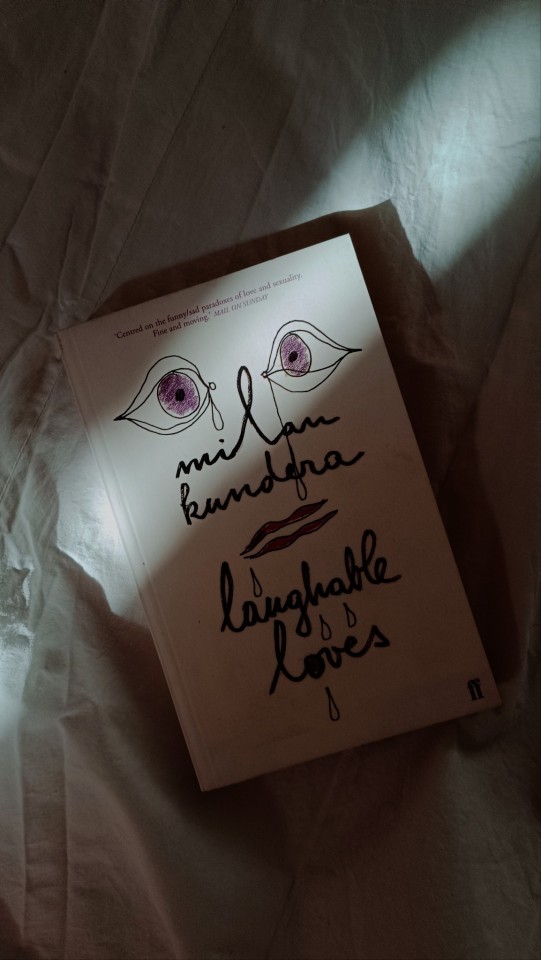#taslima
Explore tagged Tumblr posts
Text
youtube
1 note
·
View note
Text


তসলিমা নাসরিনের শোধ / Laughable Loves by Milan Kundera
#the light was very tempting#some bookstagram moments#my photography#p#taslima nasrin#shodh#milan kundera#laughable loves#bookblr#dark academia#bangla tag
34 notes
·
View notes
Text

My Girlhood, Taslima Nasrin (Auto-biography, 422 pages, Hardcover, Penguin Random House India)
2 notes
·
View notes
Text

Travel Destination: Bangladesh
Cyber Mage by Saad Z. Hossain
The mercenary Djibrel has to carry a machete wherever he goes. Only a swift beheading can ensure the job gets done anymore. Djibrel navigates the crowded streets, humans teeming with genetic mutations, looking for answers about what happened to the Djinn, a magical super race of genies who seem to have disappeared, or merged, with humans for survival. What Djibrel doesn't know is that his every move is being tracked by the infamous Cyber Mage – better known to his parents as Murzak, a privileged snarky teenager who regularly works for a Russian crime syndicate with a band of elite hackers.
And Murzak is about to embark on one of his biggest challenges: attending high school IRL. But when he discovers a brand new type of AI, operating on a dark web from the abandoned Kingdom of Bahrain that he thought was just an urban myth, Murzak and Djibrel will have to face the unimaginable in an already inconceivable world.
The Aunt who Wouldn’t Die by Shirshendu Mukhopadhyay
Somlata has just married into the dynastic but declining Mitra family. At eighteen, she expects to settle into her role as a devout wife in this traditional, multi-generational family. But then Somlata, wandering the halls of the grand, decaying Mitra mansion, stumbles upon the body of her great aunt-in-law, Pishima.
A child bride widowed at twelve, Pishima has finally passed away at the ripe old age of seventy. But she isn't letting go just yet. Pishima has long harbored a grudge against the Mitras for keeping her in perpetual widowhood, never allowed to fall in love. Now, her ghost intends to meddle in their lives, making as much mischief as possible. Pishima gives Somlata the keys to her mysterious box of gold to keep it out of the Mitras' hands. However, the selfless Somlata, witnessing her new family waste away their wealth to the brink of bankruptcy, has her own ideas.
The Love & Lies of Rukhsana Ali by Sabina Khan
Rukhsana is unable to come out to her conservative Muslim parents, she keeps that part of her identity hidden. And that means keeping her girlfriend, Ariana, a secret from them too. Luckily, only a few more months stand between her carefully monitored life at home and a fresh start at Caltech in the fall. But when Rukhsana's mom catches her and Ariana together, her future begins to collapse around her.
Devastated and confused, Rukhsana's parents whisk her off to stay with their extended family in Bangladesh where, along with the loving arms of her grandmother and cousins, she is met with a world of arranged marriages, religious tradition, and intolerance. Fortunately, Rukhsana finds allies along the way and, through reading her grandmother's old diary, but will it be enough to save her from what her family has planned.
Djinn City by Saad Z. Hossain
Indelbed is a lonely kid living in a crumbling mansion in the super dense, super chaotic capital Of Bangladesh. His father, Dr. Kaikobad, is the black sheep of their clan, the once illustrious Khan Rahman family. A drunken loutish widower, he refuses to allow Indelbed to go to school, and the only thing Indelbed knows about his mother is the official cause of her early demise: "Death by Indelbed."
But When Dr. Kaikobad falls into a supernatural coma, Indelbed and his older cousin, the wise-cracking slacker Rais, learn that Indelbed's dad was in fact a magician and a trusted emissary to the djinn world. And the Djinns, as it turns out, are displeased. A "hunt" has been announced, and ten year-old Indelbed is the prey. Still reeling from the fact that genies actually exist, Indelbed finds himself on the run. Soon, the boys are at the center of a great Diinn controversy, one tied to the continuing fallout from an ancient war, with ramifications for the future of life as we know it.
Revenge by Taslima Nasrin
In modern Bangladesh, Jhumur marries for love and imagines life with her husband, Haroon, will continue just as it did when they were dating. But once she crosses the threshold of Haroon's lavish family home, Jhumur is expected to play the role of a traditional Muslim wife: head covered, eyes averted, and unable to leave the house without an escort. When she becomes pregnant, Jhumur is shocked to discover that Haroon does not believe the baby is his, demanding an immediate termination of the pregnancy.
Overwhelmed by his distrust, Jhumur plots her payback in the arms of a handsome and artistic neighbor.
#world reading challenge#read the world#booklr#bangladesh#cyber mage#saad z hossain#djinn city#the aunt who wouldn’t die#Shirshendu Mukhopadhyay#the love & lies of rukhsana ali#sabina khan#revenge#taslima nasrin#sci fi#contemporary#lgbtq books#fantasy
1 note
·
View note
Text
: Unlocking Success in the Digital Realm: A Deep Dive into Modern Marketing Strategies
Title: Unlocking Success in the Digital Realm: A Deep Dive into Modern Marketing Strategies
In the rapidly evolving landscape of the digital age, mastering the art of digital marketing is more crucial than ever for businesses aiming to thrive in the online realm. Digital marketing encompasses a vast array of strategies and channels, all aimed at reaching and engaging with a target audience in the digital space. In this exploration, we will delve into the key components of digital marketing, shedding light on the strategies that can unlock success and propel businesses to new heights.
Understanding the Digital Landscape:
Digital marketing is not a one-size-fits-all endeavor. It involves a comprehensive understanding of the digital landscape, where consumers are inundated with information and choices. With the majority of people spending a significant amount of their time online, businesses must strategically position themselves to capture the attention of their target audience.
At the heart of any successful digital marketing strategy lies a well-optimized website. A website serves as the digital storefront for a business, making the first impression on potential customers. Ensuring that a website is user-friendly, visually appealing, and responsive across devices is paramount. Search engine optimization (SEO) plays a pivotal role in driving organic traffic to the website, making it easily discoverable by search engines.
Content is King:
In the realm of digital marketing, content is undeniably king. High-quality, relevant, and valuable content not only attracts the attention of the target audience but also establishes credibility and authority in the industry. From blog posts and articles to videos and infographics, diverse content formats cater to different preferences and consumption habits.
Social Media Mastery:
Social media platforms have become indispensable channels for digital marketing. With billions of active users on platforms like Facebook, Instagram, Twitter, and LinkedIn, businesses can connect with their audience on a personal level. Crafting engaging and shareable content, running targeted ads, and fostering community engagement are essential elements of a successful social media strategy.
Email Marketing Excellence:
Despite the rise of various communication channels, email marketing remains a powerful tool for businesses. A well-executed email marketing campaign can nurture leads, build relationships with customers, and drive conversions. Personalization, segmentation, and automation are key elements in optimizing email marketing efforts.
Pay-Per-Click Advertising:
Pay-per-click (PPC) advertising allows businesses to reach a targeted audience through paid advertisements on search engines and other platforms. By bidding on relevant keywords, businesses can ensure that their ads appear when users search for specific terms. Effective PPC campaigns require thorough keyword research, compelling ad copy, and continuous optimization for better results.
Data-Driven Decision Making:
In the digital era, data is a goldmine for marketers. Analyzing user behavior, tracking key performance indicators (KPIs), and deriving insights from data analytics tools empower businesses to make informed decisions. Data-driven marketing enables marketers to understand what works, what doesn't, and iterate on strategies for continuous improvement.
The Role of Influencers:
Influencer marketing has emerged as a dynamic strategy to leverage the popularity and credibility of individuals with a significant following. Collaborating with influencers who align with a brand's values can extend its reach and authenticity. From social media influencers to industry experts, influencers can play a pivotal role in shaping the perception of a brand.
Evolving Trends in Digital Marketing:
The digital marketing landscape is constantly evolving, with new trends shaping the way businesses connect with their audience. Artificial intelligence (AI), voice search optimization, chatbots, and interactive content are just a few examples of emerging trends that marketers need to embrace. Staying abreast of these trends ensures that businesses remain relevant and competitive in the ever-changing digital landscape.
Conclusion:
In conclusion, digital marketing is a multifaceted discipline that demands a strategic and dynamic approach. From website optimization to social media mastery, each component plays a crucial role in building a robust online presence. By understanding the digital landscape, leveraging the power of compelling content, and staying abreast of evolving trends, businesses can unlock success in the digital realm and connect with their audience in meaningful ways. The key lies in adaptability, creativity, and a relentless commitment to delivering value in the digital space. As technology continues to advance, those who master the art of digital marketing will undoubtedly find themselves at the forefront of success in the digital era.
0 notes
Video
youtube
তাসলিমা সরকার শীতের রাতে গরম করা নাচ দিলেন । দেখলেই বুঝবেন। Taslima Sark...
#youtube#তাসলিমা সরকার শীতের রাতে গরম করা নাচ দিলেন । দেখলেই বুঝবেন। Taslima Sarkar । Baul Gaan । Bangla Song https://www.youtube.com/watch?v=GSzsmMw
0 notes
Text
youtube
#তাসলিমা সরকার নাচে গানে মাথা নষ্ট করে দিলো। নতুন আকর্ষণ স্টুডিওতে দেখিয়ে দিলেন। Projapoti Baul Song#https://www.youtube.com/watch?v=beadW5BRY8o#প্রজাপতি মিউজিক#projapoti music hd#বাউল গান#বিচ্ছেদ গান#বাংলা ফোক গান#baul song 2025#bangla folk song#projapoti music#projapoti baul song#song#folk song#ফোক গান#ভান্ডারী গান#tiktok song#viral song#bangla dance#2025#ভাইরাল নাচ#projapoti song#তাসলিমা সরকার#taslima sarkar baul gaan#taslima sarkar#taslima#তাসলিমা সরকার নাচে গানে মাথা নষ্ট করে দিলো#নতুন আকর্ষণ স্টুডিওতে দেখিয়ে দিলেন#Projapoti Baul Song#bangla new song#প্রজাপতি মিউজিখ
0 notes
Text

El abrazo de la muerte, Taslima Akhter
0 notes
Text
আলিয়া-রণবীর নয়,শুধুমাত্র এই অভিনেতার জন্য ‘রকি অউর রানি’ দেখলেন তসলিমা, জানেন কে
বক্স অফিস কাঁপাচ্ছে করণ জোহরের ‘রকি অউর রানি কি প্রেম কাহানি’। মুক্তির পর থেকেই দর্শক মনে দাগ কাটতে সফল রণবীর-আলিয়ার এই ছবি। মুক্তির প্রথম ১০ দিনে ১০০ কোটির গণ্ডি পার করে ফেলেছে করণ জোহরের পরিচালনায় তৈরি সাত নম্বর ছবি। করণ জোহরের এই ছবিতে বাঙালি কন্যের চরিত্রে অভিনয় করেছেন আলিয়া ভাট। রানি চট্টোপাধ্যায়ের ভূমিকায় যতটা নজর কেড়েছেন আলিয়া, ততটাই প্রশংসা কুড়িয়েছেন এই ছবিতে আলিয়ার বাবা-মা’র চরিত্রে…
View On WordPress
0 notes
Text
The Quiet Violence of Censorship
“You don’t have to burn books to destroy a culture. Just get people to stop reading them.”
-Ray Bradbury
Censorship has long been a tool for controlling narratives, silencing dissent, and shaping public perception. A silent war not waged with weapons but with burning pages, banned books and severed tongues. A quiet rewriting of memory, and the stripping away of voices deemed inconvenient.
Whether through book burnings, suppression of indigenous knowledge, or the persecution of scientific thought, history has shown us that restricting access to information serves those in power. But censorship isn’t just a relic of the past—it just takes new forms in the modern age.
While we no longer burn books in public squares, we still see their removal from schools, libraries, and public discourse under the guise of “protection” or “political correctness”. Threats against artists, bans on films, labeling books as “anti-national”, “immoral”, or “inappropriate.” We don’t need to burn a book for it to disappear—it simply needs to be disapproved by those in power.
The suppression of information is not just confined to history books and scientific research; it extends to literature as well. Not only is it global but also regional. In India, it is not a foreign phenomenon. Manuscripts written in native scripts were destroyed during colonial rule. Dalit writers, tribal historians, and feminist poets were systematically pushed to the margins. Even today, books that challenge prevailing narratives or expose uncomfortable truths continue to be banned and censored, often under the guise of “protecting society”. Books like The Diary of Anne Frank, 1984, and Fahrenheit 451, which ironically speaks of censorship, have been banned for being deemed “too dark” or “too political”.
And still, we are asked: Why does this matter?
Because erasing history is erasing identity. When a story is silenced so is someone’s truth. When The Diary of Anne Frank was banned for being “too depressing,” or 1984 for being “too political,” we don’t just lose access to a book—we lose ideas. Books like The God of Small Things by Arundhati Roy or Lajja by Taslima Nasreen were met with bans and outrage because they dared to tell uncomfortable truths. Madhorubagan by Perumal Murugan was so fiercely attacked that the author declared, “The writer is dead.” Censorship doesn’t just stifle speech—it crushes the spirit. When books are erased so is our ability to think critically—to question, to shape our ideas and ourselves, and learn from the past.
Fiction often carries deep truths. Homer’s Iliad and Odyssey aren’t just myths; they were shaped by real-life events and continue to influence culture and beliefs, much like the Ramayana and Mahabharata. Novels like The Handmaid’s Tale, The Hunger Games, Shatter Me and The Maze Runner may feel dystopian, but they reflect real-world issues- censorship, oppression, resistance, and challenging unfair authority.
The Poppy War gives you a view of history or war, and the horrors of it in the East. To Kill a Mockingbird tells you of racial injustice and morality. They all contain warnings. These are not merely stories—they are resistance written in metaphor. They whisper of power, injustice, survival, and choice.
Some advocate restricting books with graphic content from young readers, that they must be protected from harsh realities. Others argue that shielding them from difficult topics hinders critical thinking. To an extent, this is true— Heavier themes are best understood as our thoughts and perspectives mature with age.
There’s little point in reading something when you’re too young an age just for the sake of it, if you do not understand it, or the emotional depth or context of the book. A sense of fulfillment in understanding the hidden meanings, the emotions, and the severity of such books. This deeper understanding of literature is what makes books so powerful—and why they have always been at the center of political and ideological struggles.
But shielding young people entirely does more harm than good. Literature, when introduced thoughtfully, can become a catalyst for empathy, resilience, and critical thinking. It prepares us for the world, not just protects us from it. Whether fiction or nonfiction, every book carries the weight of its time, reflecting the ideas, conflicts, and aspirations of the society that produced it.
What we choose to censor reflects what we fear. And fear is often rooted in the desire to control. When we silence women’s voices, we fear their independence. When we erase racial narratives, we fear difference. When we exclude caste-based or minority perspectives, we fear confrontation with the truth of inequality. But a society that cannot face its reflection cannot grow.
Books have always been political. They reflect the thoughts, ideologies, and events of the time they were written—even fiction. They hold up mirrors to society, amplifying both its beauty and its rot. Every page is a form of protest or preservation. And every reader becomes a co-conspirator—choosing either silence or curiosity. Every side of the story is important.
Literature analyses and critiques the social norms and politics, both past and present, allowing us to shape our opinions and beliefs. As we read, we hear the unheard voices; of those oppressed and those who had a chance to shout. To discern right from wrong. And as we write, we tell the stories—of those who cannot speak up for themselves, who strive to make a change and amplify their voices.
India is a land of stories. From the oral poetry of Kabir to the bold prose of Ismat Chughtai, our literary history is filled with voices that challenge orthodoxy. The Bhakti movement used poetry to critique caste and religious control. Progressive writers risked imprisonment to write about class struggle. Literature is not separate from our freedom—it has always helped shape it.
So what does censorship have to do with you?
Everything.
Because the moment we stop questioning, we stop reading. If we stop reading, we stop learning. We begin to forget.
Art has flowed in our veins for centuries. It has stained our walls and decorated our homes, songs, and ceremonies in every way, shape, and form. Everything we know—our history, our culture, our perspectives, even science—comes from a place of wonder, from the stories we tell and stories we read.
Humans are still young, young compared to our planet, and even younger compared to the universe. We cannot glimpse the future, so we move forward by looking at the past. History and literature are just as important as any other. It’s our way of leaving a mark on the world.
Libraries are sanctuaries, places which are meant to be protected, where the past, present, and future exist together. A library is a protest in itself: a place where all ideas sit side by side, equal in access if not in ideology. To remove even one book from its shelf is to declare that some thoughts do not deserve space.
In the end, stories are more than entertainment. They are warnings, comforts, legacies, and truths. If we let them disappear, so do we.
Because we are what we read. We are the questions we ask, the stories we inherit, and the silences we choose to break.
We are creatures of wonder and curiosity. And books just feed that wonder—they are reflections of our fears, dreams, and truths. In every page, we find not just a story, but ourselves.
-S.R
#books#censorship#bannedbooks#free speech#writers of tumblr#authoritarianism#burn the silence#resistance through writing#the power of words#writing community#spilled ink#essays on tumblr#dystopian#narrative control
11 notes
·
View notes
Photo





https://www.contemporaryartdaily.com/project/taslima-ahmed-at-westfalischer-kunstverein-munster-28418
70 notes
·
View notes
Text

🦇 Roses in the Mouth of a Lion Book Review 🦇
❓ #QOTD What's your favorite 80s song OR what are you currently reading? 🦇 Razia Mirza grows up amid the wild grape vines and backyard sunflowers of Corona, Queens, alongside her best friend, Saima. When a family rift drives the girls apart, Razia’s heart is broken. She finds solace in Taslima, a new girl in her close-knit Pakistani-American community, all while trying to manage the religious and cultural expectations of her family. When Razia is accepted to a prestigious high school in Manhattan, the gulf between the person she is and the daughter her parents want her to be, widens. There, she meets Angela, and is attracted to her in a way that blossoms into a new understanding. When their relationship is discovered by an aunty in the community, Razia must choose between her family and her own future.
💜 Razia resonated with me so much. Growing up Muslim, not realizing your sexuality is even an option, then realizing it's wrong, a sin your parents may never accept...it's heartbreaking for a child, for anyone. Muslim communities are tight-knit, breathing truth to the "it takes a village" mentality of raising children. That community can become supportive, empowering, encouraging; a warm, soothing blanket of security. However, it can also become hot, itchy, stifling; it can keep you from recognizing who you truly are. Sometimes you need to leave that security to recognize that person, and who you want to be. Bushra Rehman has done a stunning job of conveying that sense of community while showing us the little ways Razia began feeling like an outsider among the friends and family who raised her. This is the type of book, a potential classic, I wish was required reading (because when has a book with a Muslim, Pakistani FMC ever been considered required reading?).
💙 Raiza is a compelling, real and raw character. The story begins from her childhood, allowing us to see her grow and recognize the woman she wants to become over time. Because of that, there are some pacing issues. However, the prose is so enthralling, almost hypnotic in a sense, that it keeps you going until the end. Though I didn't LOVE the abrupt ending, I understood why it stopped there; everything moving forward would be up to Raiza, perhaps for the first real time in her life.
🦇 Recommended for fans of Evil Eye and The Skin & Its Girl.
✨ The Vibes ✨ 🌹 Pakistani-American FMC 🦁 Muslim-American FMC 🌹 Lesbian / Queer 🦁 Female Friendships 🌹 Coming-of-Age Story 🦁 Literary Fiction 🌹 Friends to Lovers 🦁 Sapphic Romance
💬 Quotes ❝ I wanted to be chosen by someone. ❞ ❝ You can’t wait for anyone to teach you. Otherwise you’ll learn all the wrong things. ❞ ❝ Our parents had left their homes and the thread had unraveled, then been woven again with us. This was how it always was, an unraveling and a raveling of the earth, the ground we stood on. Nothing was sacred, everything was sacred, everything changed, everything stayed the same. ❞ ❝ I hate having to lie, but there’s no other way I can make them happy and still live my life. ❞ ❝ But the rest of us, the majority, were children of not- so- rich immigrants. We were the dreams, the ones expected to take our paper airplanes and turn them into rocket ships rising into higher orbits. ❞ ❝ The rumors, not the truth, were enough to destroy a girl’s reputation. ❞
#books#queer book review#book reviews#book review#queer books#queer book recs#literary fiction#lesbian romance#lesbian pride#lesbian books#lesbian fiction#lesbian#queer fiction#queer romance#queer#book quote#book quotes#quotes#friends to lovers#coming of age#muslim writers#muslim americans#batty about books#battyaboutbooks#alice in wonderland#botanical garden#books and flowers#flowers
3 notes
·
View notes









